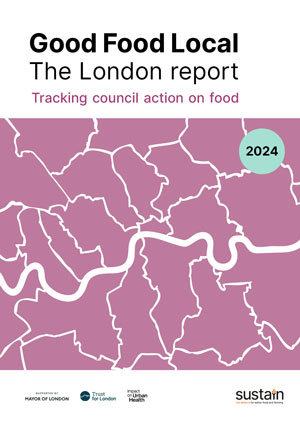In our annual Overall and Beyond the Food Bank league tables and series of good food maps, we shine a light on each council's approach to food partnerships, household food insecurity and the wider food system.
What does the report cover?
This year, we updated the measures to align with Sustainable Food Places’ six key themes. As a result, we have several new sections, and the ‘food access for Black, Asian and minority ethnic people’ section has been expanded to encompass work on ethnic and cultural diversity across all six key themes.
Food governance and strategy - looks at council action on taking a joint-up approach to food through food partnerships, policy and strategies.
Food growing and other community food action - assesses council action to support more people to grow their own food, increase land available for growing, as well as build a local good food movement and platform community voices.
Healthy food for all: tackling food poverty - reviews council action to address food poverty looking ‘Beyond the Food Bank’, with a focus on tackling the root causes of poverty and increasing dignified access to good food.
Healthy food for all: healthier food environments - from schools, workplaces and communities to catering, high streets and advertising hoardings, our measures of a healthier food environment encompass areas that affect the lives and health of local communities.
Sustainable food economy - reviews how councils are joining up work on improving the local economy and regeneration, with the availability of affordable, healthy and sustainable food including any work undertaken under the Good Food Retail agenda.
Catering and procurement - assesses one of the key areas where councils can act to reduce food-related emissions, and promote climate and nature-friendly food while supporting local economies.
Food for the Planet – looks at commitments and actions taken on food to tackle the climate and nature emergency including signing up to the Every Mouthful Counts Toolkit.
How does the report help councils take action?
The report is a valuable resource to support councils and food partnerships to identify where to take action on critical food issues that affect the food system as a whole.
By illustrating clearly where councils are making progress, and areas that might need more capacity and resource, this report helps councils make the case to continue to take action on food.
It also includes case studies to share good practice and a league table to celebrate achievements and benchmark performance year on year to give a wider view of progress.
Survey approach
As in previous years, Sustain designed a survey to collect the information used and scored in this report, based on our decades of close work with councils on food issues. External partners and feedback from councils were used to shape criteria. All councils in London were invited to complete a survey and self-report on action taken and future plans. Where available, data from external sources has been included for councils that did not respond to our survey.
The scoring and maps show three levels of action based on survey responses: foundations, good practice and leadership. For some measures, we identified actions to indicate a council’s progress level; for some measures, it was the total number of actions taken that was used to determine the level.
The league tables provide an overview of council performance in each theme (indicated by colours), how they ranked comparatively (indicated by order and percentage score), with an indication of councils who achieved overall leadership.
Case studies
Celebrating the good work taking place across the capital is an important part of this report. We have worked with several councils to put together inspiring case studies to showcase the innovative work they are doing to help residents to access healthy, affordable and sustainable food.
What's happening in your borough?
This report is coordinated by the Good Food Local and London Food Poverty teams at Sustain, to celebrate and encourage action by councils on good food issues, spanning policy areas which sit under several council departments.
We are grateful to the GLA, Trust for London and Impact on Urban Health for providing the funding that makes this work possible.






